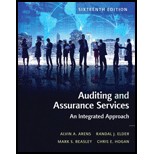
Auditing and Assurance Services (16th Edition)
16th Edition
ISBN: 9780134065823
Author: Alvin A. Arens, Randal J. Elder, Mark S. Beasley, Chris E. Hogan
Publisher: PEARSON
expand_more
expand_more
format_list_bulleted
Question
Chapter 1, Problem 13.3MCQ
To determine
Identify the feature of compliance auditing.
Expert Solution & Answer
Want to see the full answer?
Check out a sample textbook solution
Students have asked these similar questions
Bowen Corporation had sales revenue of $925,000 and cost of goods sold of $555,000. Operating expenses were $245,000, which included depreciation expense of $35,000. The company also recorded interest expense of $28,000. What was Bowen Corporation's income before taxes? Answer
Provide correct answer this general accounting question
Provide answer
Chapter 1 Solutions
Auditing and Assurance Services (16th Edition)
Ch. 1 - What are the information and established criteria...Ch. 1 - Prob. 2RQCh. 1 - Discuss changes in accounting and business...Ch. 1 - Prob. 4RQCh. 1 - Identify the three main ways information risk can...Ch. 1 - Prob. 6RQCh. 1 - Prob. 7RQCh. 1 - Prob. 8RQCh. 1 - Prob. 9RQCh. 1 - Prob. 10RQ
Ch. 1 - Prob. 11RQCh. 1 - Prob. 12.1MCQCh. 1 - Prob. 12.2MCQCh. 1 - Prob. 12.3MCQCh. 1 - Prob. 13.1MCQCh. 1 - Prob. 13.2MCQCh. 1 - Prob. 13.3MCQCh. 1 - Prob. 14.1MCQCh. 1 - Prob. 14.2MCQCh. 1 - Prob. 14.3MCQCh. 1 - Prob. 15DQPCh. 1 - Busch Corporation has an existing loan in the...Ch. 1 - Prob. 17DQPCh. 1 - James Burrow is the loan officer for the National...Ch. 1 - Prob. 19DQPCh. 1 - Prob. 20DQPCh. 1 - Prob. 21DQPCh. 1 - Prob. 22DQPCh. 1 - As discussed in the chapter opening vignette and...Ch. 1 - Prob. 24DQP
Knowledge Booster
Similar questions
- Can you solve this general accounting problem with appropriate steps and explanations?arrow_forwardI want to this question answer for General accounting question not need ai solutionarrow_forwardI am searching for the accurate solution to this general accounting problem with the right approach.arrow_forward
- Please explain the solution to this general accounting problem with accurate principles.arrow_forwardCan you show me the correct approach to solve this financial accounting problem using suitable standards?arrow_forwardCan you solve this general accounting question with accurate accounting calculations?arrow_forward
arrow_back_ios
SEE MORE QUESTIONS
arrow_forward_ios
Recommended textbooks for you
 Auditing: A Risk Based-Approach (MindTap Course L...AccountingISBN:9781337619455Author:Karla M Johnstone, Audrey A. Gramling, Larry E. RittenbergPublisher:Cengage Learning
Auditing: A Risk Based-Approach (MindTap Course L...AccountingISBN:9781337619455Author:Karla M Johnstone, Audrey A. Gramling, Larry E. RittenbergPublisher:Cengage Learning Auditing: A Risk Based-Approach to Conducting a Q...AccountingISBN:9781305080577Author:Karla M Johnstone, Audrey A. Gramling, Larry E. RittenbergPublisher:South-Western College Pub
Auditing: A Risk Based-Approach to Conducting a Q...AccountingISBN:9781305080577Author:Karla M Johnstone, Audrey A. Gramling, Larry E. RittenbergPublisher:South-Western College Pub Accounting Information SystemsAccountingISBN:9781337619202Author:Hall, James A.Publisher:Cengage Learning,
Accounting Information SystemsAccountingISBN:9781337619202Author:Hall, James A.Publisher:Cengage Learning,

Auditing: A Risk Based-Approach (MindTap Course L...
Accounting
ISBN:9781337619455
Author:Karla M Johnstone, Audrey A. Gramling, Larry E. Rittenberg
Publisher:Cengage Learning

Auditing: A Risk Based-Approach to Conducting a Q...
Accounting
ISBN:9781305080577
Author:Karla M Johnstone, Audrey A. Gramling, Larry E. Rittenberg
Publisher:South-Western College Pub


Accounting Information Systems
Accounting
ISBN:9781337619202
Author:Hall, James A.
Publisher:Cengage Learning,